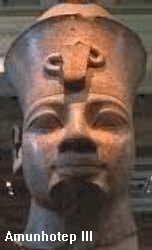




Upon his assumption to the throne, there appeared no living sister for him to marry and thus strengthen his claim to the throne (this would later be challenged). He was anywhere from 10 - 12 years of age at the time. The queen mother, promoted to GRW status on the death of the heiress Yare[t], took matters into her own hands. Acting for the first two years as unofficial regent, she decided to marry her son to her niece, Tiye. She was the daughter of Yuaa, Mutemwiya's assumed brother and a woman of high station, Tuyu (Thuya, Tjuiu). This woman's titles were: Royal Ornament, & Superior of the Harim of Amun.
Although speculation abounds on her parentage, the best that can be said is that she was in that important institute that from time to time had produced queens and certainly kings. At a guess, I would say she was a secondary princess, the daughter of Amenhotep II and a lesser queen (though in the direct royal line).

In year 2, Amenhotep command scarabs to be made, announcing his marriage to Tiye. Although his chief queen, Tiye never carried the title of "Gods Wife". Ordinarily, had she not married the king, she would have inherited her mother's titles. This fact points to her being quite young when this marriage took place. The royal couple had possibly to wait a minimum of 5 years before any sign of a child would be likely. Except for one expedition into Nubia, the kings reign was marked by diplomacy. By now, egypt's might was known abroad and foreign princes' had given up the idea of testing that theory. In year 10, another series of scarabs were issued when, through diplomatic maneuvors, Amenhotep married the daughter of Shuttarna, King of Mittani. Gilukhipa was a young princess when she journeyed to egypt with over 300 attendants. There is no record of the couple's children.

In the following 25 years, numerous foreign princesses would grace the harim of the king. Among his many wives, another known by name was: Taleka - Princess of Babylonian Princess, possibly given the egyptian name of Venitu / Ventiu. An egyptian queen, Tia'ha claimed the title of "Princess", which may point to the fact that he had half-sister's living and married at least one of them. By year 30, Amenhotep had built a great palace complex called Malkata, at thebes. It was here that he resided till his death. Prior to this, he'd married a daugther of his named Iset (Isis). In year 30, he married what is thought to be another daughter, Sitamen II. Again, no names for any children are to be found.
It was also at this time that Amenhotep decided to start the process of his own diefication, while still alive. Evidence shows that before his death, he considered himself a living god, Re incarnate. He is shown on reliefs wearing clothing and jewelry that were normally reserved for gods. In several phases that went with this transformation, he is always depicted in various stages of the aging process.

It was also at this time period that Akhenaten's last two daughters were born
and given the compounded name endings of Re. This and a stele found at Akhetaten
of the him and his wife under the aten rays, cinches the matter of a coregency
for me. Towards the end, the mismangement of government was in the hands of
Amenhotep's officials. This would be taken further in Akhenaten's own brief solo
reign. Amun had grown more powerful then the king, owning slaves,temples, land,
treasures, and even countries. The priesthood were not afraid to voice there
opposition and from as recent as the crowning of Thutmose III, had been involved
in the succession to the throne. For a god-king, this was an intolerable
position to be placed in.
The answer was the Aten. The results would be
catastrophic for egypt and the royal house.